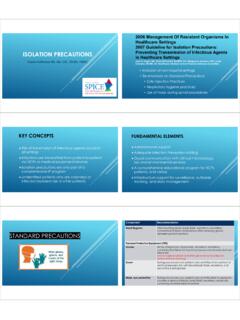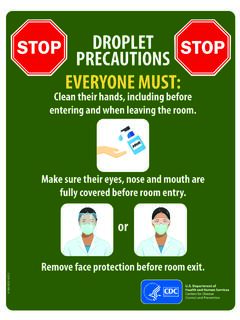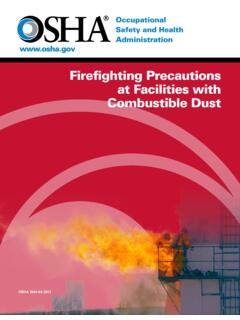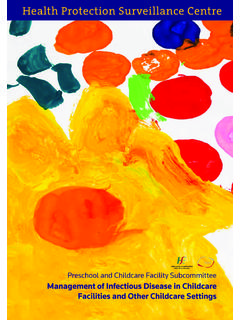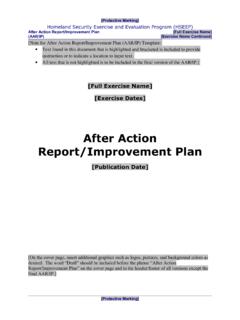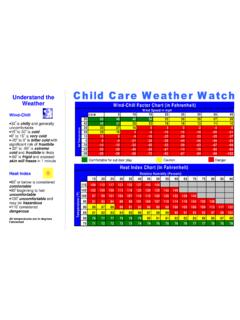Transcription of Universal Precautions and Infection Control
1 This curriculum was prepared by PHI for the SEIU Healthcare Illinois Personal Assistant Training Program. Handouts: Universal Precautions and Infection Control . Page 1 Universal Precautions and Infection Control1 Handouts Activity 1: Overview of Infection Handout 1 Infections and Germs Handout 2 How Germs Spread Handout 3 Who Is Most Likely to Get Sick from Germs Handout 4 Signs of Infection Handout 5 Infection Control and Universal Precautions Handout 6 Strategies for Controlling Infections Handout 7 Washing Your Hands 1 This curriculum is an open source document, licensed under the Creative Commons Attribution-Noncommercial-Share Alike Unported License ( ). Individuals and organizations are free to use and adapt this curriculum, in whole or in part, for noncommercial use, as long as there is full attribution to PHI ( ). (Please refer to the Title Page and Acknowledgments for full attribution of all material used in this curriculum.) You may distribute the resulting work only under the same or similar license to this one.
2 Universal Precautions and Infection Control This curriculum was prepared by PHI for the SEIU Healthcare Illinois Personal Assistant Training Program. Handouts: Universal Precautions and Infection Control . Page 2 Activity 2: Infection Control Strategies, Universal Precautions , and Consumer Education Handout 8 Wearing Gloves Handout 9 Cleaning Up Germs Handout 10 Making Cleaning Products Activity 3: Demonstration and Practice Lab: Hand Washing, Using Gloves, and Mixing Universal Solutions Handout 11 Build Your Skills: Washing Your Hands Handout 12 Build Your Skills: Putting On and Taking Off Gloves Activity 4: Demonstration: Disposing of Wastes Handout 13 Touching and Washing Dirty Laundry Safely Handout 14 Getting Rid of Wastes Safely Handout 15 Getting Rid of Sharps Safely Universal Precautions and Infection Control This curriculum was prepared by PHI for the SEIU Healthcare Illinois Personal Assistant Training Program. Handouts: Universal Precautions and Infection Control .
3 Page 3 Infections and Germs It s important to understand infections and how they spread. Here s what you need to know. What are infections? Infections are problems or diseases that happen when germs get into the body and grow. What are germs? Germs are tiny living things. They live almost everywhere, inside and outside our bodies. Some germs help people. Others cause problems or diseases. Types of germs include: Bacteria Fungi Parasites Viruses Handout 1 Universal Precautions and Infection Control This curriculum was prepared by PHI for the SEIU Healthcare Illinois Personal Assistant Training Program. Handouts: Universal Precautions and Infection Control . Page 4 How Germs Spread Page 1 of 4 Infection is spread in 3 stages: Stage 1 Germs live in a host. The host may be a person or an animal. Stage 2 The germs move out of the first host. Stage 3 The germs move into a new host. Coronavirus 19 spreads the same way as other infections and can be defined as a respiratory illness caused by a new strain of coronavirus.
4 It is important to get tested for COVID-19 for the safety of yourself and others. Testing There are two kinds of tests available: viral tests and antibody tests. A viral test tells you if you have a current Infection . This test uses a long swab to collect material from the back of the nose where it meets the throat. An antibody test, which is a blood test, might tell you if you had a past Infection . An antibody test might not show if you have a current Infection because it can take 1 3 weeks after the Infection for your body to make antibodies. Having antibodies to the virus that causes COVID-19 might provide protection from getting infected with the virus again. The CDC guidance for what to do if you are sick is: If you have a fever, cough or other symptoms, you might have COVID-19. Most people have mild illness and are able to recover at home. If you think you might have been exposed to COVID-19, contact your healthcare provider. Handout 2 Universal Precautions and Infection Control This curriculum was prepared by PHI for the SEIU Healthcare Illinois Personal Assistant Training Program.
5 Handouts: Universal Precautions and Infection Control . Page 5 Prevention Page 2 of 4 The best way to prevent illness is to avoid being exposed or exposing others to a virus or other germs. You can protect yourself by: Washing your hands often with soap and water for at least 20 seconds especially after you have been in a public place, or after blowing your nose, coughing, or sneezing o If soap and water are not readily available, use a hand sanitizer that contains at least 60% alcohol. Cover all surfaces of your hands and rub them together until they feel dry. Avoiding contact with people who are sick. Stay 6 feet (about 2 arms length) from other people. Covering your mouth and nose with a mask when around others. everyone should wear a mask in public settings and when around people who don t live in their household. Always covering your mouth and nose with a tissue when you cough or sneeze or use the inside of your elbow and do not spit. Throw used tissues in the trash and wash your hands immediately.
6 Cleaning AND disinfecting frequently touched surfaces daily. This includes tables, doorknobs, light switches, countertops, handles, desks, phones, keyboards, toilets, faucets, and sinks. Being alert for symptoms. Watch for fever, cough, shortness of breath, or other symptoms of COVID-19. It is especially important if you are running essential errands, going into the office or workplace, and in settings where it may be difficult to keep a physical distance of 6 feet. Take your temperature if symptoms develop. Handout 2 Universal Precautions and Infection Control This curriculum was prepared by PHI for the SEIU Healthcare Illinois Personal Assistant Training Program. Handouts: Universal Precautions and Infection Control . Page 6 How Germs Spread Page 3 of 4 Germs use many routes to get from one host to another. Here are six ways that germs spread: 1. Through the air The first host coughs, sneezes or exhales droplets. The new host breathes in the germs. 2.
7 Through animal bites 3. Through insect bites 4. Through eating or drinking infected food or water Handout 2 Universal Precautions and Infection Control This curriculum was prepared by PHI for the SEIU Healthcare Illinois Personal Assistant Training Program. Handouts: Universal Precautions and Infection Control . Page 7 How Germs Spread Page 4 of 4 5. Through touching The first host and the new host touch each other. Germs move from one open sore to another. Scabies and lice spread from one body to another. 6. Through body fluids Germs get out of the first host in: Blood Fluid from a cut Fluid from a penis or vagina Mucus Pus Saliva Stools Urine Vomit Germs get into the new host when infected body fluids: Are on a needle or other sharp thing that goes into the skin of the new host Get into a cut or scratch Touch mucus membranes, like those inside your mouth The CDC offers additional guidance for people who care for a person with a disability at the following website.
8 Handout 2 Universal Precautions and Infection Control This curriculum was prepared by PHI for the SEIU Healthcare Illinois Personal Assistant Training Program. Handouts: Universal Precautions and Infection Control . Page 8 Who Is Most Likely to Get Sick from Germs Some people are more likely than others to get sick from germs. They are susceptible to germs. Susceptible people may be: Already sick Under stress Very old Very tired Very young Susceptible people may be people who: Don t eat a healthy diet Don t wash their hands well Have a weak immune system. That means their body is not good at fighting off things from outside. Handout 3 Universal Precautions and Infection Control This curriculum was prepared by PHI for the SEIU Healthcare Illinois Personal Assistant Training Program. Handouts: Universal Precautions and Infection Control . Page 9 Signs of Infection Page 1 of 2 It s important to know the signs of Infection . Here s what to look for.
9 If a cut is infected: Fluid comes out of the cut. The cut hurts. The skin around the cut is red and puffy. It feels warm. If a body part or body system is infected, a consumer may feel: Pain in the infected area Sick to their stomach, or throw up Very hot or cold Very tired What To Do If You Are Sick Stay at home except to get medical care. Isolate if you are sick. Isolation is used to separate people infected with the virus from people who are not infected. In the home, anyone sick should separate themselves from others by staying in a specific sick room or area and using a separate bathroom if available. People who are in isolation should stay home until it is safe for them to be around others. You can be with others after: At least 14 days since symptoms first appeared and At least 24 hours with no fever without fever-reducing medication and Symptoms have improved Quarantine is used to keep someone who might have been exposed to COVID-19 away from others.
10 Those who have been exposed to COVID-19 include encountering someone who has been diagnosed with COVID-19 or if you ve been in a setting where you were not able to social distance. Quarantine helps prevent spread of disease that can occur before a person knows they are sick or if they are infected with the virus without feeling symptoms. People in quarantine should stay home, separate themselves from others, monitor their health, and follow directions from their state or Handout 4 Universal Precautions and Infection Control This curriculum was prepared by PHI for the SEIU Healthcare Illinois Personal Assistant Training Program. Handouts: Universal Precautions and Infection Control . Page 10 local health department. If you are sick you should also: Page 2 of 2 Avoid public transportation, ride sharing, taxis, or any situation where you would be in an enclosed space with someone Monitor yourself of COVID-19 symptoms including fever, cough, and shortness of breath Wear face masks over your nose and mouth if you must be around other people or animals Cover your mouth and nose with a tissue when you cough or sneeze and throw away the used tissues.
